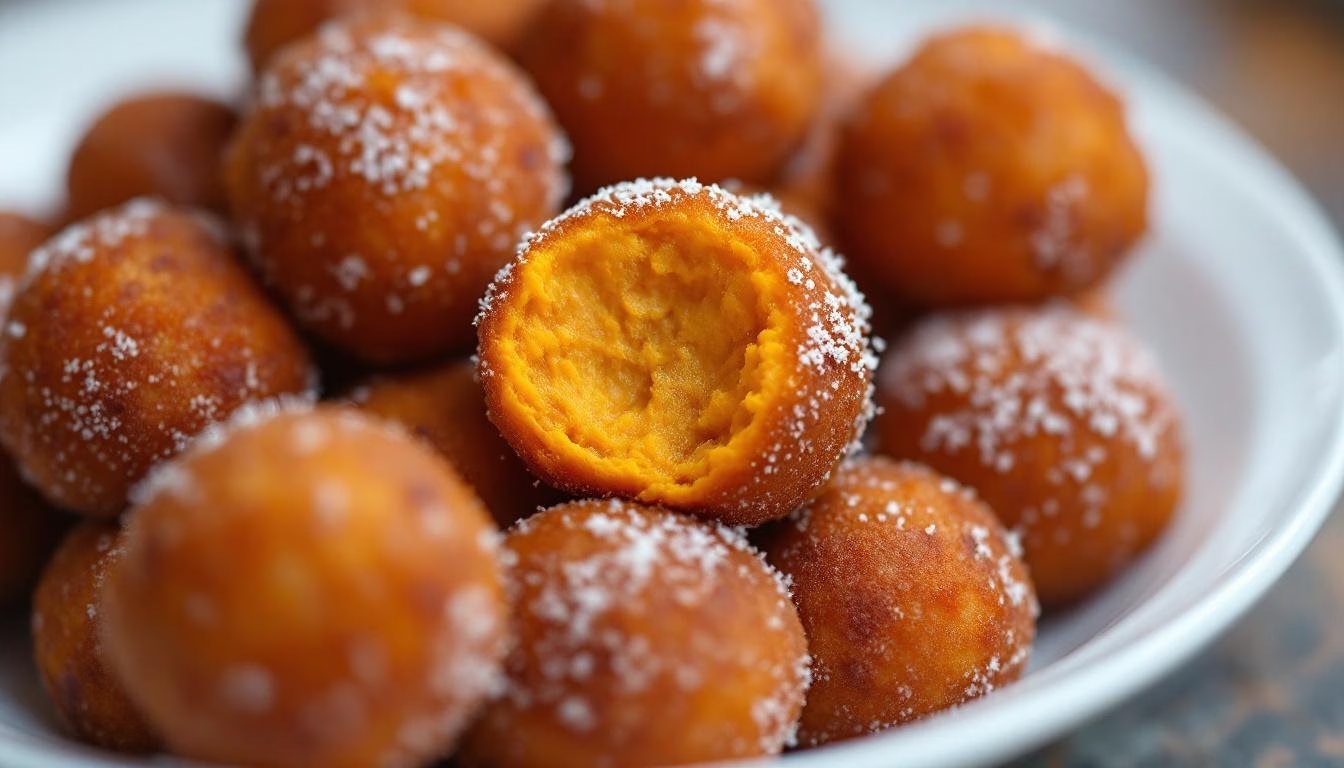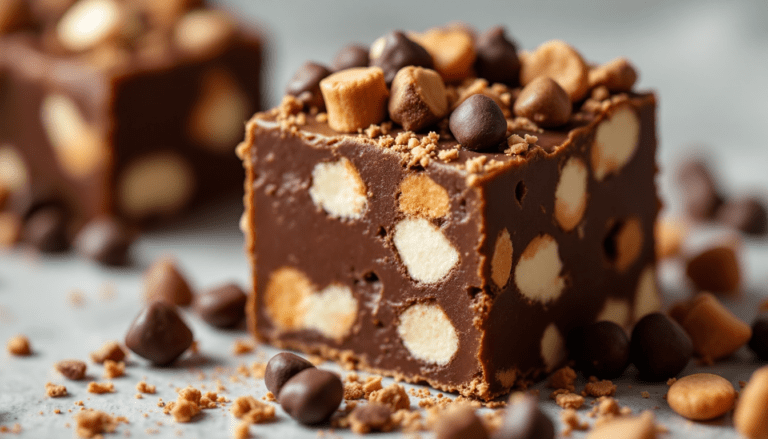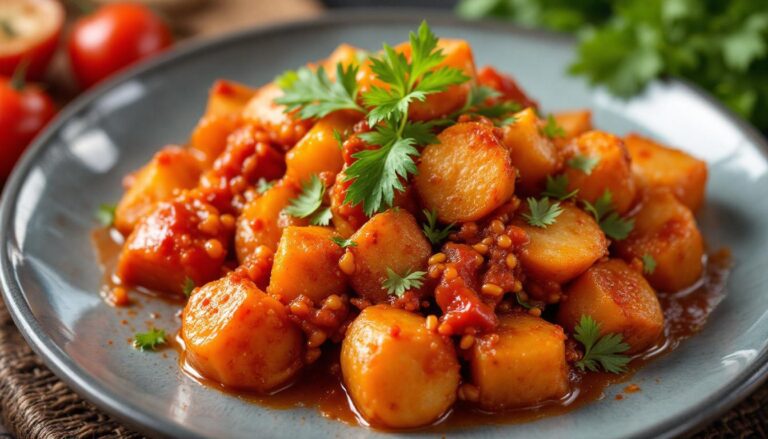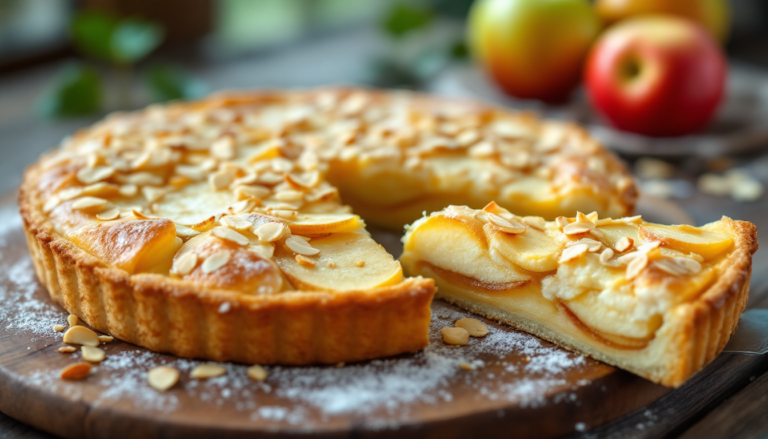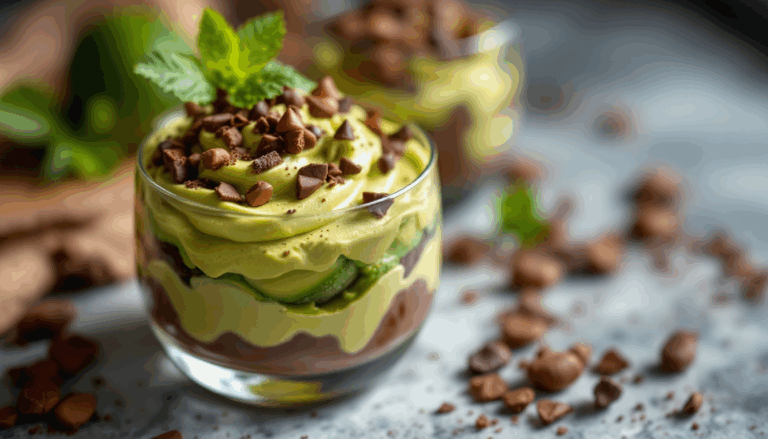Kolak Biji Salak Recipe – Indonesian Sweet Potato Balls
The Sweet Comfort of Kolak Biji Salak (Indonesian Sweet Potato Balls) Recipe – Last month, I found myself standing in my kitchen at 2 AM, jet-lagged and desperately craving something I couldn’t quite name.
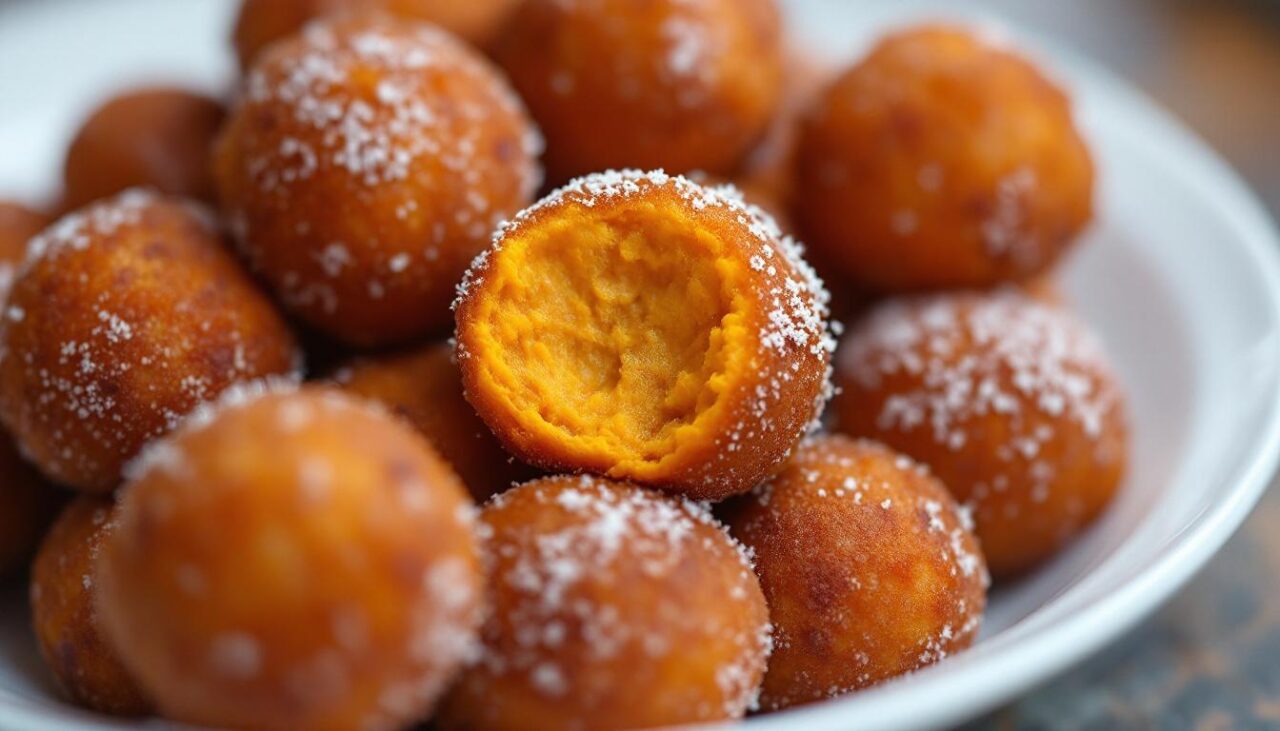
Kolak Biji Salak
Ingredients
- 1 lb. sweet potato ((454 grams) peeled and diced (its about 4 cups diced))
- 1 ½ cup tapioca flour (190 grams)
- 1/2 tsp salt
- 4 cups water
- 1 cup palm sugar (or coconut sugar)
- ½ teaspoon salt
- 3 pandan leaves (chopped or knotted)
- 2 tablespoons tapioca starch
- 3 tablespoons water
- 1 coconut milk
- 3 pandan leaves (knotted)
- 2 tablespoons palm sugar
- ¼ teaspoon salt
- ½ teaspoon vanilla extract
- ¼ cup grated fresh coconut
- 10 mint leaves
- Sliced fresh pandan leaf
Instructions
- Steam or boil the sweet potato pieces for about 7 minutes until fork-tender. Cool in a colander for 10 minutes until comfortable to handle.
- In a large mixing bowl, combine the cooled sweet potato, tapioca flour, and salt. Use your hands to knead until the mixture is smooth and dough-like.
- Roll the dough into small balls, using about 1 heaping tablespoon for each.
- Bring a pot of water to a rolling boil over high heat. Add the formed sweet potato balls and cook for a couple of minutes until they rise to the surface. Carefully remove them with a slotted spoon.
- In a deep saucepan, bring the water, knotted pandan, palm sugar (or coconut sugar), and salt to a boil over high heat.
- In a separate small bowl, mix the tapioca starch with water to make a smooth paste. Remove the pandan leaves and slowly pour the starch slurry into the simmering sugar water, stirring continuously. Once bubbling, turn off the heat and set aside.
- In another saucepan, combine the canned coconut milk, knotted pandan leaves, 1/2 teaspoon salt, and 1/2 teaspoon vanilla extract. Heat gently over low heat while stirring, then simmer for a few minutes until fragrant and slightly thickened. Remove the pandan and set aside.
- To serve, ladle a generous amount of palm sugar porridge into each bowl, add a few sweet potato dumplings, and drizzle with the aromatic coconut sauce. Optionally garnish with grated coconut, one or two mint leaves, and a thin slice of fresh pandan.
Nutrition
You know that feeling — when your body is confused about time zones, but your soul knows exactly what it wants?
I’d just returned from a trip to Jakarta, where I’d spent an evening wandering through a bustling night market, sampling everything from grilled satay to towering bowls of shaved ice.
But what kept haunting me wasn’t the spicy rendang or the crispy martabak — it was a humble bowl of something called kolak biji salak that an elderly vendor had pressed into my hands with a knowing smile.
The moment that first spoonful hit my tongue, I understood why Indonesians consider this dessert pure comfort food.
Imagine tender, chewy sweet potato balls bobbing in a fragrant, amber-colored syrup that tastes like a warm hug from your grandmother.
The pandan leaves — those magical green blades that smell like vanilla’s exotic cousin — infused everything with an almost floral sweetness that made my eyes flutter closed in pure bliss.
And then there was the coconut milk, rich and creamy, swirled on top like a silky cloud.
Standing there in my American kitchen weeks later, surrounded by the familiar chaos of measuring cups and flour-dusted counters, I realized I had to recreate that moment.
Not just the flavors, but the feeling — that sense of being cared for, of finding sweetness in simplicity.
This Kolak Biji Salak (Indonesian Sweet Potato Balls) recipe became my midnight project, my love letter to a dessert that somehow manages to be both exotic and deeply familiar at the same time.
Authentic Kolak Biji Salak Recipe – Comfort Food Dessert
Kolak biji salak holds a cherished place in Indonesian cuisine, particularly during Ramadan when families gather to break their fast with something sweet and nourishing.
The name literally translates to “snake fruit seed porridge,” though don’t worry — there are no actual snake fruits involved!
The sweet potato balls just happen to resemble the dark, glossy seeds of the salak fruit, which is where this Kolak Biji Salak (Indonesian Sweet Potato Balls) recipe gets its poetic name.
What makes this dessert absolutely magical is how it balances textures and flavors with an almost meditative simplicity.
The sweet potato balls have this wonderful chewiness — not quite like mochi, but with that same satisfying bounce against your teeth.
They’re swimming in a palm sugar syrup that’s been perfumed with pandan leaves, creating a flavor profile that’s sweet but never cloying, exotic but somehow comforting.
The coconut milk adds richness without overwhelming the delicate sweetness of the palm sugar.
This isn’t just dessert — it’s breakfast, afternoon snack, or late-night comfort food, depending on your mood and the time of day.
Indonesian families often serve it warm during cool evenings or at room temperature when the weather’s sweltering.
- Perfect Peanut Butter Cheesecake Recipe | Easy No-Bake
- Bread and Butter Pudding Recipe: Comfort in Every Bite
- Roti Kukus Recipe: Indonesian Sweet Steamed Bread
- Martabak Manis Indonesian Pancakes Recipe
- A Simple Apple Frangipan Tart Recipe That Tastes Like All-Day Baking
- The Best Sticky Toffee Pudding Recipe That’ll Make You Lick The Plate
The beauty of this Kolak Biji Salak (Indonesian Sweet Potato Balls) recipe lies in its versatility and the way it adapts to whatever you need it to be.
Gathering Your Ingredients
Before we dive into making this Kolak Biji Salak (Indonesian Sweet Potato Balls) recipe, let’s talk about the stars of the show.
Sweet potatoes are your foundation here — I prefer the orange-fleshed variety because they’re naturally sweet and create the most beautiful golden balls.
You’ll need about a pound, which sounds like a lot but trust me, they cook down significantly.
Tapioca flour is absolutely crucial and not interchangeable with regular flour.
It’s what gives the balls their characteristic chewiness and helps them hold together during cooking.
You can find it in most Asian grocery stores or order it online — it’s worth seeking out the real deal.
The Magic of Pandan
Pandan leaves are the secret weapon in this recipe, and if you’ve never worked with them before, you’re in for a treat.
These long, blade-like leaves smell like vanilla had a baby with fresh grass and a hint of coconut.
If you can’t find fresh pandan (check Asian markets first!), pandan extract works in a pinch, though you’ll miss out on the visual drama of those gorgeous green leaves floating in your syrup.
Palm sugar brings a complex, almost molasses-like sweetness that regular sugar just can’t match.
It’s darker, richer, and has these wonderful caramel notes that make the syrup absolutely irresistible.
Coconut sugar makes an excellent substitute if palm sugar proves elusive.
Essential Equipment
You don’t need anything fancy for this Kolak Biji Salak (Indonesian Sweet Potato Balls) recipe — just a steamer or large pot for cooking the sweet potatoes, a mixing bowl sturdy enough for some serious kneading, and a couple of saucepans for the syrup and coconut milk.
A slotted spoon is your best friend for fishing out the cooked balls without burning your fingers.
Making the Sweet Potato Balls
The first step in this Kolak Biji Salak (Indonesian Sweet Potato Balls) recipe is getting your sweet potatoes perfectly tender.
I prefer steaming over boiling because it doesn’t waterlog the potatoes, but either method works.
You want them fork-tender but not mushy — think perfectly baked potato texture.
Once they’re cool enough to handle (and this is important — hot sweet potatoes will make your dough sticky and unmanageable), you’ll mash them with the tapioca flour and salt.
This is where the magic happens, and where your hands become your best tools.
The Art of Kneading
Kneading this dough feels different from bread dough — it’s more forgiving but also more delicate.
You want to work it just enough to bring everything together into a smooth, pliable mass.
The dough should feel slightly sticky but hold together when you squeeze it.
If it’s too wet, add a bit more tapioca flour; if it’s too dry, a tiny splash of water will help.
Rolling the balls is oddly therapeutic.
I aim for about a tablespoon of dough per ball, but don’t stress about perfect uniformity — slight variations actually make the finished dish look more rustic and appealing.
The balls will puff slightly when cooked, so don’t make them too large.
Cooking the Balls
This is the moment of truth in any Kolak Biji Salak (Indonesian Sweet Potato Balls) recipe.
Bring your water to a proper rolling boil — not a gentle simmer, but an enthusiastic bubble.
Drop in the balls and watch for the magic moment when they float to the surface.
This usually takes 2-3 minutes and signals that they’re perfectly cooked.
Don’t overcrowd the pot, and work in batches if necessary.
Overcooked balls become mushy, while undercooked ones will be dense and heavy.
When they float, they’re done — trust the process!
Creating the Perfect Syrup
The syrup is where this Kolak Biji Salak (Indonesian Sweet Potato Balls) recipe really shines.
Palm sugar and pandan leaves transform simple water into something that tastes like liquid comfort.
The key is getting the pandan flavor just right — too little and you miss the aromatic magic, too much and it becomes overpowering.
I like to bruise my pandan leaves slightly before adding them to the syrup.
Just give them a gentle twist or tie them in a knot — this helps release more of their essential oils into the liquid.
The syrup should taste sweet but not cloying, with that distinctive pandan fragrance wafting up from the pot.
Thickening with Tapioca
The tapioca slurry is what transforms your syrup from thin and watery to glossy and coating.
Mix the tapioca starch with cold water until completely smooth — any lumps will create an unpleasant texture in your finished syrup.
Add it slowly while stirring constantly, and watch as the syrup transforms before your eyes.
Don’t panic if it seems too thick at first — it will thin out slightly as it cools.
You want a consistency that coats the back of a spoon but isn’t gluey.
If you accidentally make it too thick, a splash of hot water will thin it out.
The Coconut Milk Component
The coconut milk in this Kolak Biji Salak (Indonesian Sweet Potato Balls) recipe isn’t just stirred in — it’s gently heated with its own pandan leaves and seasonings to create a fragrant, silky sauce.
This extra step makes all the difference between good kolak and absolutely transcendent kolak.
Heat the coconut milk gently — high heat will cause it to separate and become grainy.
You want it just warm enough to release the pandan fragrance and slightly thicken.
The vanilla extract might seem like an unusual addition, but it enhances the natural vanilla notes in the pandan beautifully.
Troubleshooting and Tips
After making this Kolak Biji Salak (Indonesian Sweet Potato Balls) recipe dozens of times, I’ve learned a few tricks that make the difference between good and great.
First, don’t skip the cooling time for the sweet potatoes — working with them while they’re too hot will result in sticky, unworkable dough.
If your sweet potato balls fall apart during cooking, your dough was probably too wet.
Next time, add a bit more tapioca flour or let the cooked sweet potatoes cool longer to release more moisture.
Storage and Reheating
This dessert keeps beautifully in the refrigerator for up to three days, though the balls will absorb some of the syrup over time.
To reheat, warm gently on the stove with a splash of water or coconut milk to loosen the syrup.
Don’t microwave — it makes the balls tough and rubbery.
You can also make the components ahead of time and assemble just before serving.
The balls can be cooked and stored in the refrigerator, while the syrup and coconut milk keep well separately.
Ingredient Substitutions
If you can’t find pandan leaves, try adding a few drops of pandan extract to both the syrup and coconut milk.
Start with less than you think you need — the extract is quite potent.
In a pinch, a tiny bit of vanilla extract with a drop of green food coloring will give you the color, though you’ll miss the unique pandan flavor.
Coconut sugar works beautifully in place of palm sugar, though the flavor will be slightly different — a bit more caramel-forward and less complex.
Regular brown sugar is a last resort, but add a tablespoon of molasses to approximate the depth of palm sugar.
Creative Variations
Once you’ve mastered the basic Kolak Biji Salak (Indonesian Sweet Potato Balls) recipe, there’s room for creativity.
I love adding a handful of cooked black glutinous rice for extra texture and visual appeal — the contrast between the orange balls and dark rice is stunning.
Some families add sliced bananas or chunks of jackfruit to their kolak, turning it into a more substantial dessert.
Young coconut strips add wonderful texture, while a sprinkle of toasted sesame seeds provides a nutty crunch.
Seasonal Adaptations
During summer, I sometimes serve this chilled or at room temperature, which transforms it into a refreshing treat.
In winter, I’ll add warming spices like a small piece of ginger or a cinnamon stick to the syrup — not traditional, but delicious.
For special occasions, try making the balls with purple sweet potatoes for a dramatic color contrast, or add a small piece of coconut palm sugar inside each ball for a surprise burst of sweetness.
Presentation Ideas
While kolak is traditionally served in simple bowls, it’s beautiful enough for company.
Try serving it in clear glasses to show off the layers, or garnish with edible flowers and fresh mint for an elegant touch.
A sprinkle of toasted coconut flakes or a drizzle of extra coconut milk makes it feel extra special.
The Sweet Reward
Making this Kolak Biji Salak (Indonesian Sweet Potato Balls) recipe is like giving yourself a warm hug from the inside out.
Don’t expect perfection on your first try — like any traditional recipe, it gets better with practice.
Your first batch might have slightly lopsided balls or syrup that’s a touch too thick, and that’s perfectly okay.
What you will get is something deeply satisfying and surprisingly addictive.
The combination of textures — chewy balls, silky syrup, creamy coconut milk — creates this wonderful interplay in your mouth that keeps you coming back for just one more spoonful.
And then another.
And maybe just one more after that.
The beauty of kolak lies not just in its flavors, but in its ability to transport you.
Whether you’re serving it to curious friends who’ve never experienced Indonesian cuisine or making it for yourself on a quiet evening, this dessert has a way of creating moments of pure contentment.
It’s the kind of food that makes you slow down, savor each bite, and appreciate the simple pleasure of something sweet and comforting.
So go ahead, give this Kolak Biji Salak (Indonesian Sweet Potato Balls) recipe a try.
Your kitchen will smell like paradise, your taste buds will thank you, and you’ll have discovered a new way to find sweetness in the everyday.
Sometimes the most extraordinary experiences come in the humblest packages — and sometimes they come floating in a bowl of amber syrup, waiting to surprise you with their simple perfection.

